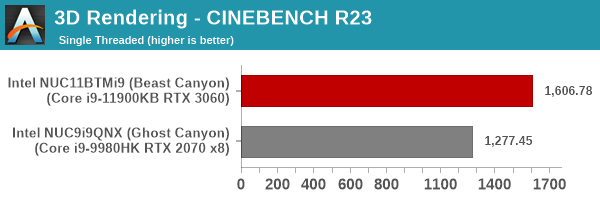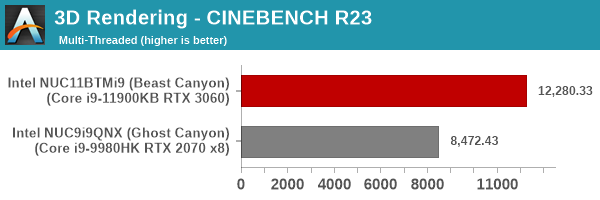Intel Beast Canyon NUC Review: Desktop Tiger Lake Debuts in SFF Gaming Powerhouse
by Ganesh T S on July 29, 2021 9:00 AM EST- Posted in
- Systems
- Intel
- NUC
- Tiger Lake
- NUC11
- Beast Canyon
Miscellaneous Performance Metrics
This section looks at some of the other commonly used benchmarks representative of the performance of specific real-world applications.
Web Browser Benchmarks - JetStream and Speedometer
Web browser-based workloads have emerged as a major component of the typical home and business PC usage scenarios. Beginning with this review, we are including browser-focused benchmarks from the WebKit developers. Hosted at BrowserBench, JetStream 2.0 benchmarks JavaScript and WebAssembly performance, while Speedometer measures web application responsiveness. We also process MotionMark, but the confidence level of the results vary as much as +/-35%. Hence, we present graphs only the Jetstream 2.0 and Speedometer results for the three top browsers below.


In order to maintain reproducibility, we self-host the BrowserBench benchmarks (git clone of the WebKit repository as on July 1, 2021). The browser versions used for the numbers above are presented in the table included in each system's review.
| Intel NUC11BTMi9 Browser Bench | |||
| Speedometer 2.0 | JetStream 2.0 | MotionMark 1.2 | |
| Microsoft Edge (92.0.902.55) |
181 ± 2.2 | 201.313 | 900.46 ± 14.16% |
| Google Chrome (92.0.4515.107) |
212.1 ± 2.1 | 201.097 | 1115.74 ± 5.54% |
| Mozilla Firefox (90.0.2.7872) |
164 ± 2.2 | 123.612 | 1072.12 ± 3.44% |
BAPCo's SYSmark 25 and UL's PCMark benchmarks both include web browser activities as part of their evaluation scheme. However, the performance for this increasingly important workload tends to get lost in the presentation of a single number. JetStream and Speedometer help us focus on how different PC configurations vary in terms of the user experience with respect to web browsers.
3D Rendering - CINEBENCH R23
We use CINEBENCH R23 for 3D rendering evaluation. R23 provides two benchmark modes - single threaded and multi-threaded. Evaluation of different PC configurations in both supported modes provided us the following results.


The microarchitectural improvements in Tiger Lake help the Beast Canyon outscore the Ghost Canyon by a significant margin.
x265 Benchmark
Next up, we have some video encoding benchmarks using x265 v2.8. The appropriate encoder executable is chosen based on the supported CPU features. In the first case, we encode 600 1080p YUV 4:2:0 frames into a 1080p30 HEVC Main-profile compatible video stream at 1 Mbps and record the average number of frames encoded per second.

Our second test case is 1200 4K YUV 4:2:0 frames getting encoded into a 4Kp60 HEVC Main10-profile video stream at 35 Mbps. The encoding FPS is recorded.

The latest Tiger Lake microarchitecture again helps the Beast Canyon come out on top.
7-Zip
7-Zip is a very effective and efficient compression program, often beating out OpenCL accelerated commercial programs in benchmarks even while using just the CPU power. 7-Zip has a benchmarking program that provides tons of details regarding the underlying CPU's efficiency. In this subsection, we are interested in the compression and decompression rates when utilizing all the available threads for the LZMA algorithm.


Cryptography Benchmarks
Cryptography has become an indispensable part of our interaction with computing systems. Almost all modern systems have some sort of hardware-acceleration for making cryptographic operations faster and more power efficient. In this sub-section, we look at two different real-world applications that may make use of this acceleration.
BitLocker is a Windows features that encrypts entire disk volumes. While drives that offer encryption capabilities are dealt with using that feature, most legacy systems and external drives have to use the host system implementation. Windows has no direct benchmark for BitLocker. However, we cooked up a BitLocker operation sequence to determine the adeptness of the system at handling BitLocker operations. We start off with a 2.5GB RAM drive in which a 2GB VHD (virtual hard disk) is created. This VHD is then mounted, and BitLocker is enabled on the volume. Once the BitLocker encryption process gets done, BitLocker is disabled. This triggers a decryption process. The times taken to complete the encryption and decryption are recorded. This process is repeated 25 times, and the average of the last 20 iterations is graphed below.


Creation of secure archives is best done through the use of AES-256 as the encryption method while password protecting ZIP files. We re-use the benchmark mode of 7-Zip to determine the AES256-CBC encryption and decryption rates using pure software as well as AES-NI. Note that the 7-Zip benchmark uses a 48KB buffer for this purpose.


Yet another cryptography application is secure network communication. OpenSSL can take advantage of the acceleration provided by the host system to make operations faster. It also has a benchmark mode that can use varying buffer sizes. We recorded the processing rate for a 8KB buffer using the hardware-accelerated AES256-CBC-HAC-SHA1 feature.


In every cryptography application, the Tiger Lake-based Beast Canyon is the runaway leader.
Agisoft Photoscan
Agisoft PhotoScan is a commercial program that converts 2D images into 3D point maps, meshes and textures. The program designers sent us a command line version in order to evaluate the efficiency of various systems that go under our review scanner. The command line version has two benchmark modes, one using the CPU and the other using both the CPU and GPU (via OpenCL). We present the results from our evaluation using the CPU mode only. The benchmark (v1.3) takes 84 photographs and does four stages of computation:
- Stage 1: Align Photographs (capable of OpenCL acceleration)
- Stage 2: Build Point Cloud (capable of OpenCL acceleration)
- Stage 3: Build Mesh
- Stage 4: Build Textures
We record the time taken for each stage. Since various elements of the software are single threaded, and others multithreaded, it is interesting to record the effects of CPU generations, speeds, number of cores, and DRAM parameters using this software.




Dolphin Emulator
Wrapping up our application benchmark numbers is the new Dolphin Emulator (v5) benchmark mode results. This is again a test of the CPU capabilities.

Overall, the CPU capabilities of the Core i9-11900KB with its new Tiger Lake microarchitecture / increased L2+L3 cache help the Beast Canyon NUC handily outwit the other contenders across all the workloads analyzed in this section.










84 Comments
View All Comments
vegemeister - Friday, July 30, 2021 - link
Actual gaming consoles are stateless or nearly so, and get rebooted fresh every time they're used.PCs that are used for gaming do not work like that.
Spunjji - Friday, July 30, 2021 - link
I have literally never had a computer that wasn't overclocked fail due to a random bit-flip memory error, but okay, I guess they were all toys and we should all be paying extra for redundant chips on our DIMMs 🤷♂️willis936 - Friday, July 30, 2021 - link
What a valuable anecdote.mode_13h - Monday, August 2, 2021 - link
In PC help forums, it's not uncommon to find users complaining of system instability, only for it to turn out they have bad RAM. ECC buys you some initial protection + notification (if you know where to look) that your RAM is failing.Unashamed_unoriginal_username_x86 - Friday, July 30, 2021 - link
there is a scale of snobbery from gamer to anti-gamer and it is a horseshoeAlso ECC is still vulnerable to remote rowhammer attacks
Oxford Guy - Wednesday, August 11, 2021 - link
Yes... if you want more security you don’t want ECC. Security via data corruption!mode_13h - Thursday, August 12, 2021 - link
> remote rowhammer attacksThat's a new one! How does it even work? A rowhammer attack hits a DRAM row so frequently that an adjacent row changes. It's an *extremely* targeted attack, and requires the attacker to have some detailed knowledge of the target process' memory layout for it to have much potential as an exploit.
Furthermore, if it works, you're just going to cause random bit-flips. To beat ECC, you actually need to cause at least 3 bit flips, or I guess only 2 if your goal is to make the process abort.
Finally, to actually fetch a row of DRAM means it can't be in the cache hierarchy. So, you've got to explicitly invalidate the cacheline or do something else to ensure it's evicted.
So, the first question is how can one *remotely* hammer a row of DRAM? Wouldn't any sort of protection against DoS attacks occur, long before you could do it? And how are you going to ensure it keeps getting evicted from the cache hierarchy?
In actual practice, the only real risk I see of Rowhammer is when one VM tenant just wants to create lots of chaos in the other tenants. It's not a complete non-issue, but also probably ranks fairly low on the scale of exploits.
And it's *certainly* not an argument against using ECC. If anything, it's yet another reason *to* use it, since ECC can correct minor instances and detect many others. Without ECC, you'd be even *more* vulnerable, and you'd be much less likely to have any clue that it's happening.
ads295 - Thursday, July 29, 2021 - link
One usually moves towards desktop PCs in order to move away from expensive-to-replace custom hardware found in laptops, amongst other things. I would not buy this if it was going to cost a bomb to replace in case of some motherboard related issue.meacupla - Thursday, July 29, 2021 - link
Other than the CPU and compute unit pcb itself, I don't see anything on the compute unit that isn't easily replaceable.PSU, GPU, RAM and SSD are all replaceable, which is really about as good as it gets for something that is using laptop parts.
Going to a desktop, the only additional thing you can replace is the CPU.
Spunjji - Friday, July 30, 2021 - link
"Other than the CPU and compute unit pcb itself"That's a pretty big "other than!" - if an ITX motherboard fails, you can replace that without buying a new CPU. Same goes for an upgrade / replacement of the CPU itself. Those are at least ~$150+ and ~$350+ expenses, respectively, for something of this calibre.